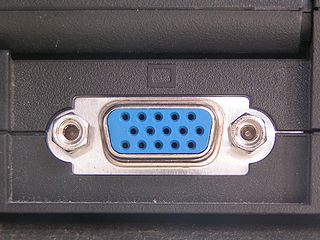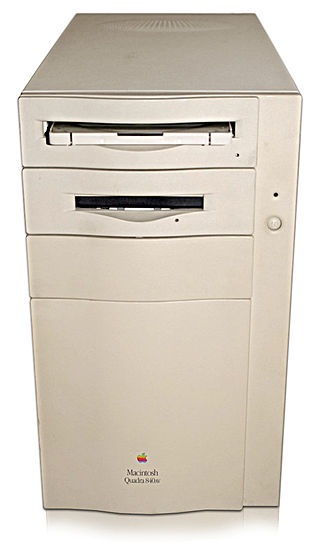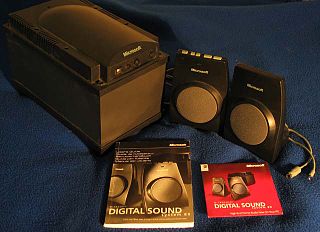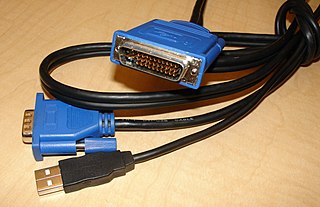
The HDI-45 was one of Apple Computer's proprietary cable-to-onboard video connectors. A 45-pin connector, the HDI stands for High-Density Interconnect.

The HDI-45 was one of Apple Computer's proprietary cable-to-onboard video connectors. A 45-pin connector, the HDI stands for High-Density Interconnect.
These connectors were used only in the first generation Power Macintosh computers (the Power Macintosh 6100, 7100 and 8100), specifically connecting these computers to the Apple AudioVision 14 Display, the only display to use this connector. Other Apple displays and third-party displays could be used with a special adapter for the receptacle on the computer ("Canneloni", Apple part M2681LL/A or 590-0796-A) [1] or a breakout cable ("Calamari", Apple M1243LL/A or 590-0793-A) for the permanently attached cable to the monitor that converts this unusual port to a standard DA-15 connector. [2] [3]
In addition to carrying analog RGB video, the connector supports analog stereo audio signals (input and output), Apple Desktop Bus (ADB), and S-video input. [4] Because the AudioVision 14 Display has front-mounted connectors for ADB and audio and video, a single consolidated cable and proprietary connector was used to simplify the connection to the computer and reduce cable clutter. [1]
| Pin | Function |
|---|---|
| 1 | Analog audio ground |
| 2 | Audio input shield |
| 3 | Audio input (L) |
| 4 | Audio input (R) |
| 5 | Audio output (L) |
| 6 | Audio output (R) |
| 7 | Reserved |
| 8 | Monitor ID sense line 1 |
| 9 | Monitor ID sense line 2 |
| 10 | Video ground/shield (G) |
| 11 | Video output (G), 75Ω |
| 12 | Video input power ground |
| 13 | +5V for camera |
| 14 | Reserved |
| 15 | |
| 16 | |
| 17 | |
| 18 | Monitor ID sense line 3 |
| 19 | S-video input shield |
| 20 | S-video input, luminance (Y) |
| 21 | S-video input, chroma (C) |
| 22 | Reserved |
| 23 | Not used |
| 24 | Reserved |
| 25 | |
| 26 | Video ground/shield (R) |
| 27 | Video output (R), 75Ω |
| 28 | I2C data signal |
| 29 | I2C clock signal |
| 30 | Reserved |
| 31 | Monitor ID |
| 32 | Monitor ID |
| 33 | Vertical sync |
| 34 | Composite sync |
| 35 | ADB power, +5V |
| 36 | ADB ground |
| 37 | ADB data |
| 38 | Keyboard switch |
| 39 | Reserved |
| 40 | |
| 41 | Monitor ID |
| 42 | Horizontal sync |
| 43 | Video sync ground |
| 44 | Video ground/shield (B) |
| 45 | Video output (B), 75Ω |

The Power Macintosh, later Power Mac, is a family of personal computers designed, manufactured, and sold by Apple Computer, Inc as the core of the Macintosh brand from March 1994 until August 2006.

A graphics card is a computer expansion card that generates a feed of graphics output to a display device such as a monitor. Graphics cards are sometimes called discrete or dedicated graphics cards to emphasize their distinction to integrated graphics processor on the motherboard or the CPU. A graphics processing unit (GPU) that performs the necessary computations is the main component in a graphics card, but the acronym "GPU" is sometimes also used to erroneously refer to the graphics card as a whole.
Apple Desktop Bus (ADB) is a proprietary bit-serial peripheral bus connecting low-speed devices to computers. It was introduced on the Apple IIGS in 1986 as a way to support low-cost devices like keyboards and mice, allowing them to be connected together in a daisy chain without the need for hubs or other devices. Apple Desktop Bus was quickly introduced on later Macintosh models, on later models of NeXT computers, and saw some other third-party use as well. Like the similar PS/2 connector used in many PC-compatibles at the time, Apple Desktop Bus was rapidly replaced by USB as that system became popular in the late 1990s; the last external Apple Desktop Bus port on an Apple product was in 1999, though it remained as an internal-only bus on some Mac models into the 2000s.

S-Video is an analog video signal format that carries standard-definition video, typically at 525 lines or 625 lines. It encodes video luma and chrominance on two separate channels, achieving higher image quality than composite video which encodes all video information on one channel. It also eliminates several types of visual defects such as dot crawl which commonly occur with composite video. Although it improved over composite video, S-Video has lower color resolution than component video, which is encoded over three channels.

The game port is a device port that was found on IBM PC compatible and other computer systems throughout the 1980s and 1990s. It was the traditional connector for joystick input, and occasionally MIDI devices, until made obsolete by USB in the late 1990s.

The D-subminiature or D-sub is a common type of electrical connector. They are named for their characteristic D-shaped metal shield. When they were introduced, D-subs were among the smallest connectors used on computer systems.
Apple Inc. has sold a variety of LCD and CRT computer displays. Apple paused production of their own standalone displays in 2016 and partnered with LG to design displays for Macs. In June 2019, the Pro Display XDR was introduced, however it was expensive and targeted for professionals. Nearly three years later, in March 2022, the Studio Display was launched as a consumer-targeted counterpart to the professional monitor. These two are currently the only Apple-branded displays available.

The Apple Display Connector (ADC) is a display and data connector developed by Apple, Inc. as a proprietary modification of the DVI connector. ADC combines analog and digital video signals, USB, and power all in one cable. It was used in later versions of the Apple Studio Display, including the final 17" CRT model, and most versions of the widescreen Apple Cinema Display, after which Apple adopted standard DVI connectors on later models.

The Video Graphics Array (VGA) connector is a standard connector used for computer video output. Originating with the 1987 IBM PS/2 and its VGA graphics system, the 15-pin connector went on to become ubiquitous on PCs, as well as many monitors, projectors and high-definition television sets.

The Macintosh TV is a personal computer with integrated television capabilities released by Apple Computer in 1993. It was Apple's first attempt at computer-television integration. It shares the external appearance of the Macintosh LC 500 series, but in black. The Macintosh TV is essentially a Performa 520 that can switch its built-in 14" Sony Trinitron CRT from being a computer display to a cable-ready television. It is incapable of showing television in a desktop window, although it can capture still frames to PICT files.

The Power Macintosh 6100 is a personal computer designed, manufactured and sold by Apple Computer from March 1994 to March 1996. It is the first computer from Apple to use the new PowerPC processor created by IBM and Motorola. The low-profile ("pizza-box") case was inherited from the Centris/Quadra 610 and 660AV models, and replaced the Macintosh Quadra series that used the Motorola 68040 processor, Apple's previous high-end workstation line.

Apple Inc. has designed and developed many external keyboard models for use with families of Apple computers, such as the Apple II, Mac, and iPad. The Magic Keyboard and Magic Keyboard with Numeric Keypad designed to be used via either Bluetooth and USB connectivity, and have integrated rechargeable batteries; The Smart Keyboard and Magic Keyboard accessories for iPads are designed to be directly attached to and powered by a host iPad. All current Apple keyboards utilize low-profile key designs, and common modifier keys.

The Macintosh Quadra 840AV is a personal computer designed, manufactured, and sold by Apple Computer from July 1993 to July 1994. It was introduced alongside the Centris 660AV, where "AV" signifies audiovisual capabilities, such as video input and output, telecommunications, speech recognition, and enhanced audio. The 840AV has the same mini-tower form factor as the Quadra 800, with a faster Motorola 68040 processor.

The Macintosh Quadra 660AV, originally sold as the Macintosh Centris 660AV, is a personal computer designed, manufactured and sold by Apple Computer from July 1993 to September 1994. It was introduced alongside the Quadra 840AV; the "AV" after both model numbers signifies video input and output capabilities and enhanced audio.

The Digital Sound System 80, short DSS80, was a three-piece PC audio system co-developed by Microsoft and Philips. It debuted on the 1998 Electronic Entertainment Expo (E³) and is most likely the only speaker system ever released by the Microsoft Corporation. It also remains one of the very few featuring Philips' wOOx subwoofer technology.

The VESA Enhanced Video Connector (EVC) is a VESA standard that was intended to reduce the number of cables around a computer by incorporating video, audio, FireWire and USB into a single cable system, terminating in a 35-pin Molex MicroCross connector. The intent was to make the monitor the central point of connection. The EVC physical standard was ratified in November 1994, and the pinout and signaling standard followed one year later.

The Dreamcast VGA Box is an accessory for Sega's Dreamcast video game console that allows it to connect to a video display such as a computer monitor or an HDTV set through a VGA port. Because the Dreamcast hardware can produce a VGA-compatible video signal natively, this connection provides improved picture quality compared to standard composite video or S-Video connections, along with support for progressive scan video.

The Apple AudioVision 14 Display is a 14-inch Trinitron display that was manufactured by Apple Computer Inc.

A dock connector is a connector used to attach a mobile electronic device simultaneously to multiple external resources. The dock connector will typically carry a variety of signals and power, through a single connector, to simplify the process of docking the mobile device. A dock connector may be embedded in a mechanical fixture used to support or align the mobile device or may be at the end of a cable.

The Apple Studio Display is a series of non-widescreen LCD and CRT displays manufactured and sold by Apple Computer, Inc. and introduced in 1998. After the 1999 introduction of the widescreen Apple Cinema Display, the Apple Studio Display line ran concurrently until it was discontinued in 2004. With the exception of the last model, the 5:4 17" Apple Studio Display, all Apple Studio Displays had an aspect ratio of 4:3.
{{cite book}}: |website= ignored (help)
Q: What is the Integrated Desktop Cable (IDC)?
A: It's a new high-density cable for plug-and-play set-up. The IDC replaces five cables that would normally have to run from your computer to your display to provide the same AudioVision functionality (sound-in, sound-out, ADB, video-in, video-out). Now with a single "snap" you'll be connected.
Q: When do I need the AudioVision Adapter?
A: It is required on all modular Macintosh models that do not have the high-density connector on the back panel of the computer. The part number is M1243LL/A. Future Apple CPU's will support the new integrated desktop cable and, therefore, will not require the AudioVision adapter.